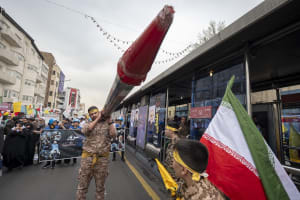INTERVIEW: 'Each person is a world' – Bringing the hostages 'everywhere'
The ‘Kidnapped from Israel’ campaign

Many individuals across the globe have seen posters depicting the 253 hostages – their faces, names and ages – in many different languages; hostages from nearly 20 nations who were abducted from Israel by Hamas terrorists and their allies on that fateful day Israelis have dubbed the 'Black Shabbat.'
Inbar Perez has a dream of being able to close the social media accounts she is currently managing to keep the hostages in the public eye.
Perez spoke to Paul Calvert, a Christian journalist based in the Middle East, about the successful poster project, which began quite organically just a few days after the Hamas massacres on Oct. 7.
“I wanted to do something,” Perez told Calvert. “I wanted to keep the hostages in the public eye. I wanted to be able to say, ‘Okay, we didn’t just give up on those people.’ I wanted the world to know. And I think that’s what the campaign is all about.”
The idea began with two Israeli artists – Nitzan Mintz and Dede Bandaid – who were in New York at the time.“They felt really helpless,” said Perez. “You know, the aftermath of the attack was… the collective shock was insane. And they just started printing posters of the kidnapped people.”
Even Perez, an Israeli living in Germany, received a message from her sister on the morning of Oct. 7.
“Every Israeli in the world, we had our share of bad news, you know?” Perez said. “I know how it is: It’s a terror attack. It’s a war that started.”
Like all of Israel that day, she was glued to the television as the victims contacted the media on air, amid the terrible attacks.
“When I think about it today, the trauma was massive. I was petrified, I was scared, I was sad and, you know, my heart was broken,” she told Calvert.
One of the first videos that Perez saw was of Shani Louk, the 22-year-old German-Israeli, whose abduction was recorded on video by Hamas terrorists, as the world looked on in shock.
“It’s one of those images that I can never shake off,” she said. “I am forever with Shani Louk in my head. I think for me, especially realizing the magnitude of the hatred toward us, like what they did to us is just.. I just couldn’t believe it.”
Perez admits that the shock and horror were so great, especially the sheer brutality inflicted upon the “beautiful kids who just went to a rave,” that she found it hard to function in her daily life for a week after the news.
She told Calvert: ”But then I heard about the campaign, and I was always an activist, you know; it’s in my blood. And I thought, ‘Okay, I need to do something.’ So in a way, I felt a little better that at least I was doing something. I think for most Israelis abroad, this feeling of helplessness was very, very hard.”
The two New York artists quickly joined forces with Tal Huber, a designer from Yavneh, Israel, and later another designer, Shira Gershoni.
Perhaps not dissimilar to a war footing in any country, one sees again - from yet another example of the uniting of Jewish people, from October 7 onwards - that the call-up in Israel went far beyond the military aspect. In fact, every Jew became a soldier that day.
She said that the creative trio began with a simple design, “like the old-fashioned Missing Persons” posters since the project began even before the names and ages of the hostages were published. Once finished, the posters were uploaded to a Dropbox folder available to the international community. People were encouraged to print the posters and hang them wherever they possibly could. Within a day, access to the folder kept collapsing due to the large online demand.
Perez joined as a social media manager about a week into the project and helped to publicize the brand new website – kidnappedfromisrael.com – in October. The site now makes the posters available in more than 50 languages thanks to the tremendous support.
In the first two months, Perez received many photos and videos from around the world. She realized that it would be important to create multilingual resources for various countries, including Australia, New Zealand, Thailand, India, the United States, as well as parts of South America, Africa and Europe.
“People all over the world just volunteered to translate them,” she said. “We bring [the kidnapped] people everywhere. I hung posters here in Hamburg for weeks. I used to go jogging in the park with posters and tape, just to continue to keep them there.
“For weeks and weeks, thousands and thousands of people all over the world, not just Israelis, not just Jews, printed the posters and hung them in public places, in subway stations, in train stations, you know, public walls, everywhere.”
Perez attributes the success of the campaign to the fact that the "hostage" posters are something anyone can do, and in their own time, without others. The website allowed Israelis, and other well-meaning people, who live abroad to feel they were helping the nation in some way.
As more news of the hostage situation emerged, it became clear to the campaign team that they needed to be in touch with the relatives of the kidnapped men, women and children, out of respect for their loved ones. As the list of names and details became clearer, a second version of the posters was designed, including name, age and an image for each individual.
“The list was updated on a daily basis for (…) more than two months,” Perez explained. “Sadly, we got confirmation about kidnapped people who were murdered. We had to update that we got new names all the time, and then we had a new series of posters, [on] which we basically gave a little bit more information about the person, for example, if they had [dual] citizenship.”
Eventually the family status, nationality and even a call to "Bring the hostages home" was added.
Calvert asked Perez if she was surprised by the amount of antisemitism that has risen from the campaign, for example, with some people tearing or pulling down the posters.
“Yes and no,” Perez replies. “I think most Israelis are not surprised about the level of hatred toward us. I think some of us – most of us – we live in the shadow of the Holocaust. We live in the shadow of antisemitism.
“I think we were mostly heartbroken to see such videos because they express so much hatred. People who are tearing apart posters of babies, of elderly, just because they’re Israelis or Jews, you know, there was absolutely no reason to tear these posters down. Absolutely none," Perez said.
"We are there to raise awareness. We are there to keep the hostages in the public eye. I’ve seen really vile posters. You know, people just use those posters as a tool to go against Israel.”
Perez told Calvert about other projects listed on the website, such as the milk cartons and the candles.
“The poster campaign had a lot of spin-offs,” she explains. “Shortly after the campaign exploded, people approached us for massive billboards, for example, people who collected money, people just donated, and the posters became huge billboards.”
A group of mothers from the United States decided to print the hostages’ faces on milk cartons. In America, Perez explains, missing persons have previously been portrayed on milk cartons. She says that even decision-makers in Congress have received these, as a reminder of the plight of some U.S. citizens, and others.
Another group of Americans decided to create candles.
“In Jewish tradition, candles are a symbol for hope, a symbol for memory,” she said. “So that was the idea, that people can actually just purchase a candle and light it, to guide the way home for those hostages.”
Everyone in the campaign is a volunteer, and the feeling is that the hostages have become family members.
“We know the names of those people. We know their stories. We know how they look. And it’s very important for us to continue everything we can, just to see them return … It's very hard to stay optimistic, but none of us is willing to give up.
Citing the Jewish concept that ‘saving one life is like saving the whole world,' Perez spoke with great emotion about the long, exhausting 136-day [at the time of interview] marathon public relations effort:
“Each person is a world, a world with family, with dreams, with children that are waiting, with parents that are waiting.
“I mean, we’re still waiting for 134 people. We were so hoping that we wouldn’t need to be here… I want to see them back home, each and every one of them. I want them to return to their families.
“As a woman, I am of course petrified of what the 14 women are going through there. We know they’re being sexually abused. I’m worried about the Bibas family, like the rest of the world. I’m worried about each and every one of the soldiers who were taken, the fathers, the elderly. There is an 85-year-old man, Shlomo Mansour. Fathers, mothers... I just really wish to see them back home.”
Perez said it is great when people reach out, ask questions, use the posters in videos, on social media pages, and to use them in any way that brings attention to the hostages being held in captivity since Oct. 7.
“We can’t forget those people,” she concludes. “We can’t forget those people.”
View the posters and stories at: www.kidnappedfromisrael.com - also on Instagram and Facebook
Click below to listen to the full interview.

The All Israel News Staff is a team of journalists in Israel.














